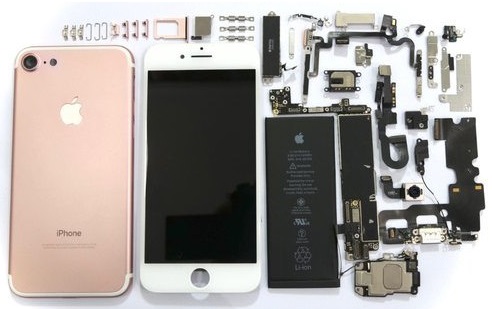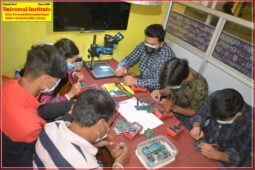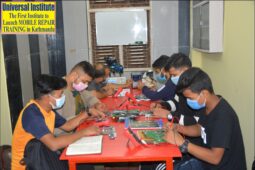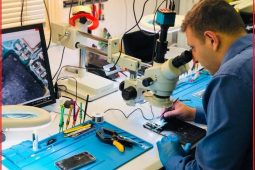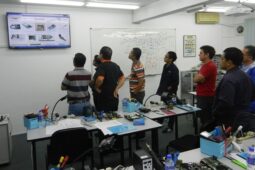Mobile Phone Repairing PDF book free download
Mobile repair book is a 120 page complete manual that answers all the basic to core level questions for entrants into mobile phone repair technical support segment. The book takes the reader one step at a time, combining a strong theoretical knowledge based on Mobile phone devices (how they function, description of their internal chip components with tutorial on the basic foundation electronics for repairing and merged it with descriptive easily, practically and getting tutorials on both hardware and software related repair procedures for Mobile phone Information about hardware and software repair tools is covered with product listings and guides for success.)
Mobile repairing book free PDF download
If there is complete guide-book on Mobile phone repair ever known, then this book is the one and only complete guide-book for mobile phones & tablet Phones repair in English language. If you are seeking for a way by which you could exchange personal services for money, then this book will be perfect for you. In all over the world, book stores have hardly a complete repair guide book for Mobile phone repairs although you may find many for PCs there. This book is for the young people, students or anyone who is seeking for a good resource for practical learning towards self reliance. This century is the age of mobile communication and computing, it is one of the important tech repair service segment. Through the pages of this book, a reader will be trained to become a great mobile phone technician with a brighter and faster earning potential than most cell phone’s technicians.
Mobile Phone Repair PDF Free 2025
What this book teaches is practicable towards becoming a good Mobile phone technician. The tutorials cover Microelectronic device dis-assembly and re-assembly, troubleshooting, BGA soldering, detailed electronics fundamentals, flash programming and many others. The book ends with a chapter of information on how to set up a shop and efficiently managing a mobile repair services support center. Discover the secrets about mobile phone repair with these books. About the Author: Er.D.P.Tiwari has setup and managed a regional training service centers within the last twenty years; taught thousands of Mobile,Computer,Laptop,TV repair technicians in partnership with governments ,NGO,INGO and individually over the past twenty years. He holds a Bachelor of Engineering(BE) in Electronics & Communication Engineering. He also holds multiple industry standard certifications from major OEMs. He consults in Information and Communication Technology, a training consultant who has mentored a good number of individuals who run successful businesses. His classes are never boring as he has a knack for making complex topics both understandable and entertaining.
Mobile Phone Parts components Identification
Inside a Mobile phone, a circuit board is one of the main components, along with various other individual sections such as the Cover(Housing),liquid crystal display (LCD), antennae pad, microphone, battery, speaker,Vibertor and Camera. The Mobile phone circuit board is considered to be, for all intents and purposes, the brain area of the phone. It runs the entire system. There are several components of the circuit board that work together to ensure the proper functioning of the Mobile phone.List of major mobile phone parts/components.
Mobile Phone Majar Parts/Components Name List
- Housing
- Back Cover (plastic & matel)
- Display (Protection glass,Touch pad & display)
- Battery
- Motherboard (PCB)
- Speaker (Ear & Ringer)
- Mic (Analog & Digital)
- Antina pad
- Camara
- Vibrator
- Sub Bard
- Flex Cable
- on/off switch
Majar Parts and Their Function
1. Mobile phone Housing
The outer shell for the protection of all the parts inside the mobile phone is called housing. The design and color may vary according to the housing mobile phone set. The housing of some of the mobile phone sets in our market is available in the market. If it is broken or discolored, a new change can be made. The main part of phone housing is made of polycarbonate, and the metallic one is made of aluminum. Nowadays, among all the plastic stuff on the shelfs, metallic phone housings are more noticeable. Usually, aluminum and magnesium are used for housings. Aluminum is very solid and light, but it is difficult to make the needed shapes and details. Magnesium alloys are comparatively good in molding, but comparing to aluminum alloys, magnesium ones are not corrosion resistant and require painting.

2. Back Cover
The back glass of a mobile phone is the rear panel of the device made of glass. It covers and protects internal components like the battery, wireless charging coil, and motherboard, while also giving the phone a sleek, premium look.
3. Mobile phone Display
The mobile phone display is really like a computer monitor. The display of the mobile phone is considered an important part because the CPU sends all the data in the mobile phone to the display as per the order given on the keypad or touch pad, including the level of the antenna tower, battery level, phone numbers, photos, mobile phone menu. Nowadays, most expensive multimedia sets use high resolution displays. The display used in mobile phones can be of the following types. The display, when combined with the touch element, is ‘the’ major element of the user interface and as such we go to great lengths when testing screens during our review process to measure a displays quality by measuring Contrast Ratio, Color Calibration, Brightness and Sunlight Legibility. 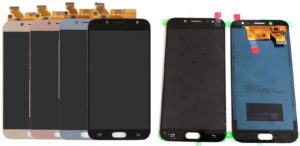
LCD : liquid crystal display technology A liquid crystal display is the most common display type among mobile phones because of its low power consumption and good image quality. They are generally easy to read, even under direct sunlight.The smallest element of an image displayed on a LCD is the pixel. Each pixel normally consists of a layer of molecules aligned between two transparent electrodes, and two polarizing filters.
LED- light emitting diodes technology A semiconductor LED diode that emits light when charged with electricity. They come in diverse colors and some LEDs even contain multiple elements and are therefore capable of emitting light with different colors.
TFT:Thin Film Transistor technology TFT technology is an active-matrix technology, meaning that a tiny circuit (a transistor) is located next to each pixel, allowing the pixel to be turned on and off individually. This permits faster response time and greater contrast compared to passive-matrix technology.
OLED:Organic Light Emitting Diode technology The term OLED is actually an acronym, and stands for organic light-emitting diode. For the unaware, a light-emitting diode is basically just a light source, and they’re used widely in electronics. But OLED is different because of the organic part. In an organic diode, there’s a thin film of organic compound that emits light when you pass an electric current through it.
IPS:In-Place Switching technology (IPS-In-Plane Switching panel) An active matrix LCD screen technology developed by Hitachi in the mid-1990s that provides more uniform color reproduction and greater viewing angles than traditional twisted nematic (TN) LCDs. Maturing for more than a decade, IPS was deployed in tab phone and various smart phones. Viewers appreciate the wide angle and color quality, because tablets are widely used as movie players and photo albums.
AMOLED/Super AMOLED: Active-Matrix Organic Light-Emitting Diode technology AMOLED display :When compared with a regular LCD display an AMOLED display consumes less power, provides more vivid picture quality, and renders faster motion response as compared to other display technologies such as LCD. However,
Super AMOLED display : It consists of a set of thin film layers of electroluminescent power-producing organic compounds and a pixel-modulating matrix. Super AMOLED is a more advanced version and it integrates touch-sensors and the actual screen in a single layer.
POLED/PMOLED: Plastic Matrix Organic Light-Emitting Diode (Flexible display) POLED display: or Plastic Light Emitting Diode, is a display technology that uses a flexible plastic substrate such as polyethylene terephthalate (PET) instead of glass for the electroluminescent organic semiconductor to be deposited. The use of more malleable plastic instead of glass allows the display panel to be bent, folded or rolled up without breakage.
PMOLED dispaly:Passive Matrix Organic Light-Emitting Diode (PMOLED) displays drive a row of pixels in the display, rather than individual pixels like AMOLED. PMOLED is cheaper to make than AMOLED, but have a restricted resolution and are not as power efficient as AMOLED, which makes PMOLED a weak candidate for high-resolution smartphone screens. PMOLED screens light up one row of pixels at a time, turning off the line as it moves to light the next row. Thus, if there are 100 lines in a PMOLED display, each line of the display is energized 1/100th of the time. This limits the size of the PMOLED display to a maximum of 5 inches with today’s technology.
The display of mobile phones has different layers as shown in the picture below. 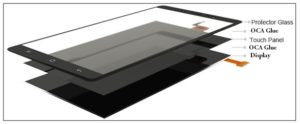
4. Mobile phone Battery
Mobile phone Battery Lithium ion batteries are considered to be one of the best batteries used in mobile phones. Currently, such batteries are widely used. Such batteries have low self-discharging ratio and can be used for longer than other batteries and weigh less. If the working capacity of the batteries decreases, it should be fully discharged and recharged. Lithium ion is the most common battery because it can store the most energy in the smallest space. That’s measured in terms of specific energy density, which refers to how much energy, in Watt-hours, a kilogram of battery could hold. For lithium ion, the figure can be between 150 and 250 Wh/kg, while a nickel metal hydride (or NiMH) battery can hold about 100 Wh/kg. In other words, lithium ion batteries are smaller and lighter than other types, and that means smaller devices with longer battery life. 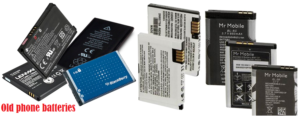
Some of the above batteries have three pins and some have four pins. If there are three PINs, Positive, BSI and Negative. BSI-Battery Standard Identification BTEMP-Battery Temperature Management
BSI: The PIN is placed on the mobile phone to identify the resistance inside the battery and the type of battery and the charging sensor.
Btemp: The pin is placed to manage the temperature of the battery. The TDR (thermistor) is placed inside the battery of the mobile phone. Since this Btemp pin of the battery is directly connected to the power IC, the supply from the battery becomes the thermistor. So the voltage is calculated by the power IC and the temperature of the battery is obtained. This PIN is not found in all mobile phone batteries.
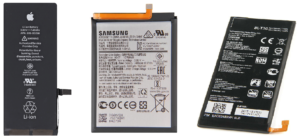
Battery capacity The capacity of a battery is measured in milliampere-hours (or mAh), which indicates how much energy the battery can deliver over time. For instance, if a battery has a rating of 1000 mAh, it could deliver 1000 milliamps of power for 1 hour. If your device uses 500 milliamps of power, the battery should last about 2 hours. The maximum voltage, ampere, watts it can give to all the batteries used in the mobile phone is written on the battery as shown in the picture below. The voltage in the battery of a mobile phone ranges from 3.7 to a maximum of 4.5 but the ampere may vary. The more amperes written on the battery, the more backup you can give. 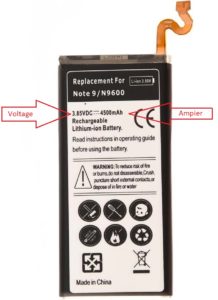
5. Mobile phone Antenna Pad
- GSM Antina Pad
- Wifi Antina Pad
- NFC Antina Pad
A steel plate / leaf is placed on top of the mobile phone set. This is called antenna pad. In most mobile phones, the antenna pad is placed at the top, but in some sets it may be placed at the bottom. In the beginning, the mobile phone sets that came in the market used to have aerial instead of such a plate, but now there is no aerial in the mobile phone sets available in the market. Both the incoming and outgoing signals from the mobile phone set come and go through this antenna pad. This plate is well integrated with the motherboard.
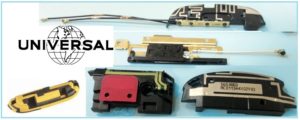
6. Mobile phone Microphone(mic)
- Analog Microphone
- Digital Microphone
The microphone receives the sound waves we speak and converts them into electrical waves. The microphone is placed at the bottom of the mobile phone set. Inside the microphone is a diagram (a sheet of shiny thin plastic) that shakes as we speak. When we move in and out in this way, a kind of electric wave is generated and our sound wave enters. There are two types of microphones used in mobile phone sets.
a. Analog Microphone
An Analog or electret microphone is a type of condenser microphone that has a permanently-polarized capsule.The capsule, which acts as a parallel-plate capacitor, is charged via a quasi-permanent electret material that is applied to either the front plate (diaphragm) or stationary backplate. With a permanent charge across the plates, any change in capacitance in the electret condenser capsule creates an inversely proportional change in voltage across the plates.
Analog Microphone mobile phones use a two-pin microphone as shown in the picture below. 
b. Digital microphone (Mems Microphone)
A MEMS Microphone(micro-electromechanical systems) mic is a pressure-sensitive diaphragm etched into a silicon wafer via MEMS processing. MEMS mics are largely based on electret capsules and typically have onboard preamps and analog-to-digital converters. MEMS mics are also known as digital mic,mic chips or silicon mics. A digital microphone MEMS design will typically have an additional metal-oxide-semiconductor (CMOS) chip that acts as an analog-to-digital converter. These chips effectively take the amplified analog audio signals and convert them into digital data. These ADCs allow digital MEMS microphones to be more easily integrated with digital products. Of all the smart mobile phone sets coming in the market today, digital microphone is the most used.
This microphone has three,four or five pins as shown in the picture below.

7. Mobile phone Speaker
- Ear Speaker
- Ringer Speaker
The speaker converts electrical waves into sound waves. The speakers used in mobile phones are very small in size. The inner structure of the speaker has a permanent magnet ring with a temporary metal in the middle and a coil between the metal and the permanent magnet. There is also a plastic cone on top of the coil and the outer metal body. When an electrical signal with voltage is given to this speaker, the coil inside it shakes. When a signal in the form of AC flows through the coil, there is a variable magnetic shock. 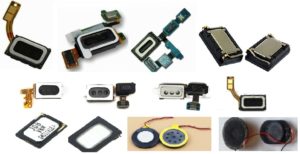
There are two types of speakers use in a mobile phone.
A. Ear speaker
B. Ringer speaker (Handsfree/Louds)
The air speaker is a bit smaller in size than the ringer speaker. The exterior design of the speaker is as shown below.
8. Mobile phone Camara
Cameras are devices used to record video to take photos on mobiles. Such cameras are placed in different megapixels according to the capacity of the mobile phone. The more megapixels the camera has, the more light this lens can capture even in low light. There are generally six types of camera available today, namely your standard main camera, ultra-wide camera, telephoto or periscope zoom camera, macro camera, monochrome camera, and depth sensor camera. 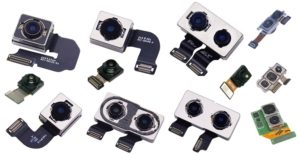
9. Mobile phone Vibrator
The vibrator used in mobile phones is like a small motor. It rotates when the supply voltage is given, thus vibrating the mobile phone. The IC that controls the vibrator switches on and off the supply voltage for a while. When the voltage is given in this way, it turns on and off for a while. The structure of the vibrator is as shown below. 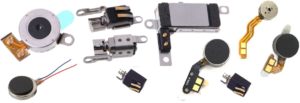
10. Motherboard (PCB)
When you open the housing of the mobile phone, you will see a board with all the components connected as shown below. This board is called Motherboard. This motherboard is the most important part of a mobile phone. Motherboard is commonly exist in Electronics devices and mobile phones. Since it contains of a variety of metals and semiconductors, it is difficult to recover the materials in PCB. The latest smartphones available on the market today, researchers and engineers are constantly developing new ways to make our phones smaller, faster and more efficient. Due to the increase in capabilities of Motherboard, Motherboard have gotten smaller in size and more powerful. This lets manufacturers put more components in a smaller amount of space to deliver all of the features. Circuit-tracing is a term used by mobile phone repair technicians to check broken tracks on the Motherboard. Many of the times problems come in cell phones, if the tracks get broken. These tracks are not visible as they are drawn inside the circuit boards. Most of these motherboards have 7-10 layers which have tracks/lines going from one end to another for supply of voltage and signals.
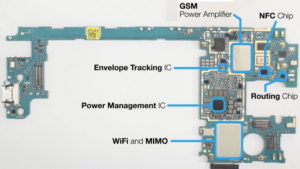
11. Sub Board/charging flex
Some mobile phones have a charging connector as shown in the picture below. This address is called sub board. When it comes to charging problems in mobile phones, this address is the worst.
12. Mobile phone Flex cable
The flexible cable used to connect two PCBs of a mobile phone is called a flex cable. The texture of this cable may vary according to the mobile phone set. Flex cables are designed to fit onto a motherboard, usually by connecting onto a socket. These sockets are made up of tiny pins which when correctly aligned, sit flush into place and create a connection between the flex and the motherboard, allowing the flex to draw power and start it’s designed function. Just like the texture of something is shown below.
13. On/off Switch
The switch used to turn the mobile phone set on and off is called on and off. We press and release such switches for some time. When the switch is pressed in this way, the ground given in one pin of the switch is connected to the other pin and reaches the power IC. 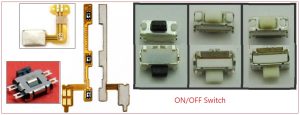
What are the chip components of a smartphone?
The Motherboard of a mobile phone has several small parts or electronic components. When learning mobile repairing, it is important to learn and understand how to identity these small smd parts or electronic components and understand their function. Identification of these small smd parts on the PCB of a mobile phone is easy if you know and understand some of the basic rules. It is also important to understand what to do if any of these small components is faulty.Most of these electronic components are SMD (Surface Mount Devices). They don’t have any leads like thru-hole electronic components.
1.Resistor
2.Capacitor
3.Inductor (Coil)
4.Diode
5.Crystal oscillator
6.Transistor
7.Band Pass Filter
8.EMI filters
9.Coupler
Mobile Phone chip components Name and Their Function
Mobile Phone components are the electronic function parts, which are soldered to the circuit board by surface mount technology. There are many types of SMD components, and each type is packaged in different forms, which results in the huge SMD components library. According to the function of SMD Mobile Phone components, they can be classified as follows, the letters in brackets represent their identification on the PCB.That is the external dimensions of the mobile phone parts. With the development of SMT technology, the industry has formed a series of standard parts for convenient operation, all parts suppliers are manufactured according to this standard.list of mobile phone small components/parts.
1.Resistor
Chip/SMT/ SMD resistors are rectangular in shape and as a result they are often known as chip resistors. They have metallised areas at either end of the main ceramic body, and in this way they can be set onto a printed circuit board that has pads onto which the two ends are set to provide the connection. There are four types of resistor used in mobile phones.
- Value Printed Resistors
- Non Value Printed Resistors
- Fuseable Resistors
- Voltage Dependent Resistors (VDR)
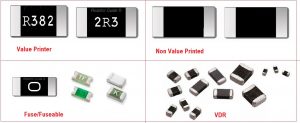
Function of Resistor
a.Value Printed Resistor and Non Value Printed Resistor Although the external structure of the two resistors above is different, the work is the same. It will pass forward by blocking voltage and current according to its capacity. It is emitted from one leg of the resistor by giving voltage to the other leg. Such as:

c.Fuseable Resistor The function of a fuseable resistor is similar to that of a fuse. Being a fuseable resistor, it works to protect other items even if it burns in case of high voltage flow or short voltage in front. If there is a short in the front part, this resistor will break itself and open the circuit. d.VDR (Voltage Dependent Register) This register is kept for security. It stops more when the voltage is high and less if the voltage is low. How much voltage it stops depends on the voltage it receives, so it is called Voltage Dependent Register.
2.Capacitor
SMD Capacitor is an electronic component made up of an insulator between two conductors. They are small, leadless and can be placed onto modern printed circuit boards using pick and place machines used in modern manufacturing. The comparisons between the the different types of capacitor is generally made with regards to the dielectric used between the plates. There are two types of capacitor used in mobile phones.
- Polar Capacitor
- Non Polar Capacitor

Function of Capacitor A, Polar Capacitor The function of this polar capacitor is to filter the DC current. It also accumulates voltage in the polar capacitor according to its capacity. B.Non Polar Capacitor This capacitor filters the signal according to its capacity. It passes the AC current lightly and stops the DC current completely.
3.Inductor (Coil) Surface Mount Inductors offer small size, and if designed on a toroidal core less leakage inductance and lower electromagnetic interference (EMI). SMD inductors are passive components that are placed during surface mount manufacturing processing. They are positive reactance devices, available in many sizes and form factors optimized for particular applications. Inductors are also used to destroy or ground unnecessary signals. If the inductor is measured in units of Henry it is indicated by the wind. There are four types of inductors used in mobile phones.
- Visible coil
- Single color
- Dual color coil
- Boost coil/Power coil
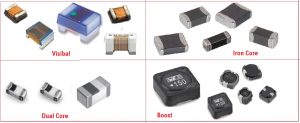
Function of Coil
a.Visible Coil b.Dual Color Coil c.Iron Core Coil Although the exterior textures of the three coils above are different, the work is almost the same. Such coils are used to soften the sound in the way of speakers and microphones in mobile phones. This gives the audio signal a slight delay, so the sound is sweet. Iron is kept inside the Iron Core Coil so it can be used to filter DC current as well as audio signal. d.Boost Coil Boost Coil works to increase the voltage according to its capacity.
4. Diode
Diode is generally made of germanium or silicon semiconductor. The semiconductor diode is a widely used electronics component found in many electronic circuit designs today. Although there are many different types of diode which use the same basic structure of an area of p-type material meeting an area of n-type material. There are four types of diode used in mobile phones.
- Rectifier diode
- Zener diode and TVS Diode
- Light emitting diode (led)
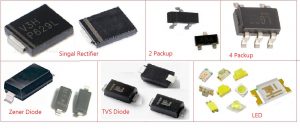 Function of Diode
Function of Diode
a.Rectifier diode
Its job is to convert AC current to DC and prevent reverse voltage. Reverse Voltage means Negative (-) Voltage instead of Positive () or Positive (-) Voltage instead of Negative (-).
d.Zener Diode / TVS Diode
The exterior design of these two diodes looks the same but two Zener Diodes are packed inside the TVS Diode. The Zener diode passes as much voltage as its voltage. This diode can be used in Parallel or Series.
e.LED (Light Emitting Diode)
This diode is a light that is placed on the keypad and display of a mobile phone to illuminate it.
5.Crystal oscillator
Inside the crystal are two sheets of quartz. Given its supply voltage, it produces a mechanical vibration and a certain frequency. Crystals that produce such fixed frequencies have different values. There are two main types of crystals used in mobile phones. There are two types of crystal used in mobile phones.
- Reference crystal (RF)
- Real time clock (RTC)

Function of Crystel
a.RF Crystal The frequency produced by RF Crystal is called CLK Frequency. The frequency it produces is used to carry various information and signals. The body outside the RF crystal is written as the frequency it produces.
b.RTC (Real Time Clock) The CLK Frequency produced by RTC is used to run Time on mobile phones.
6.Transistor(Bypolar & Mosfet)
A three terminal semiconductor electronic device is called transistor. Transistors are widely used in electronic appliances such as mobile phone,tablet phone,computers,laptop, radio,audio video equipment..etc.A transistor is a three layer semiconductor which consist a very thin central layer of one type of semiconductor material sandwiched between two relatively thick layer of second type. There are two types of transistor(bipor n mosfet) used in mobile phones.
a.To amplify the signal The function of the transistor to amplify the signal is to amplify the small input signal. Such transistors are widely used in electronics other than mobile phones. When transistors amplify any signal, they only increase the amplitude of the signal and do not make any difference to the wavelength of the signal. The signal input of the signal amplifier transistor is always given from the base pin.
b.Switching voltage The base pin of the three pins of such a transistor is given the biasing voltage to operate it. So the bias is received by the base pin of this transistor and current flows between the collector and emitter of the transistor. In this way, when the current flows in the collector and emitter, any goods in the other part can be irradiated.
c.To regulate voltage The fluctuating current and voltage cannot be given directly to any sensitive ICs. Given such an unequal voltage, the IC will not be able to work well and will deteriorate quickly. Therefore, the act of generating current and voltage in the same way is called regulator. A regulator transistor is used to generate such a current or voltage.
The transistors used in mobile phones are of the following types.
1.Bipolar transistor
- a.Voltage Regulator
- b.Voltage Switching
a.Voltage Regulator
Bipolar transistor that regulates voltage The bipolar transistor that regulates voltage is black with one large leg on the upper side and three small legs on the lower side. This type of transistor is placed in the way of charging on some mobile phones and tab phones to regulate the voltage. This transistor is not used in the smart sets coming in the market today. This regulator is a bipolar transistor that regulates.

b.Voltage switching
Voltage switching bipolar transistor The voltage switching bipolar transistor has three legs in black. This transistor has one leg on the upper side and two legs on the lower side. A transistor placed for voltage switching is called a switching transistor. The external structure of this transistor is as shown in the figure below. 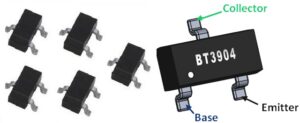
2.Mosfet transistor
A transistor made of one of the semiconductors of P / N is called a mosfet transistor. The MOSFET transistor that regulates voltage is black with 6 or 8 legs. This type of mosfet is used to give the battery a voltage regulator in the way of charging the goods like Chinese Mobile Phone, Tablet Phone, Mp3, Mp4 Player, PSP. The exterior texture of this mosfet is rectangular in shape as shown below.
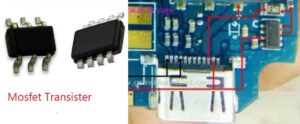
Function of Transistor
a.Voltage regulator
Voltage regulator Transistor The process of regulating Unregulate Voltage is called Voltage Regulator. The voltage regulator transistor works to equalize the voltage.
b.Voltage Switching
Voltage Switching Transistor Giving voltage only when needed is called voltage switching. Switching is the transistor that is kept for the day by switching only when the voltage is needed. Use Bipolar or Mosfet any transistor to give by switching voltage.
What is the difference between Bipolar Transistor and Mosfet Transistor? Any Bipolar or Mosfet Transistor can be used to regulate the voltage. The Mosfet Transistor has the ability to operate at a much faster speed without heat than the Bipolar Transistor, so the Mosfet is considered better than the Bipolar.
7.Band Pass Filter
Band pass filters are installed on mobile phones near network ICs. It filters the signal from the antenna and separates it according to the band. In mobile phone sets such filters are found to be used for three types of GSM, DCS and PCS band on the way to and from (RX,TX). The signal and Shape of the band pass filters is as shown below.

8.EMI filters
EMI filters are also called EMI suppression filters or display filters. It is placed near the display connector of the mobile phone to protect it from the harmful effects of electromagnetic force. The data from the processor is filtered and goes to the display of the mobile phone. When the data is filtered in this way, the picture on the display becomes a bit smooth. 
9.Coupler
The inner structure of the coupler is like a transformer. The exterior of such couplers is usually white, green or sky blue and is lightly marked with gray. The coupler of the coupler is found to be used for coupling any two signals or frequencies in the mobile phone.

10.External Antenna Socket A socket placed on a mobile phone to connect a separate antenna from the outside is called an external antenna socket. This socket has four or five legs in yellow color.
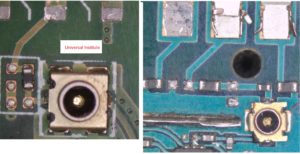
What are the main ICs of a smartphone? ICs (Integrated Circuit)
Mobile Phone IC’s and their function
An integrated circuit(IC) is small chip that can function as an amplifier, oscillator, timer, microprocessor. An IC is a small wafer, usually made of silicon, that can hold anywhere from hundreds to millions of transistors, resistors, and capacitors. These extremely small electronics can perform calculations and store data using either digital or analog technology. On the “Mobile Phone ICs Functions and Identification,” We are going to be looking at the big parts. The big parts here refer to the ICs short for integrated circuit. It is a good skill to be able to identify mobile phone ICs functions for troubleshooting purposes.
1.Power IC
As Power IC is related to Power, it is called Power IC. The main function of the power IC is to take voltage from the battery and supply regulated voltage to other ICs on the motherboard. This IC supplies the input supply voltage from the battery to other ICs in the same way even when the voltage of the battery decreases, i.e. the output voltage of the power IC is the same even when the voltage of the battery decreases slightly. The on-off switch of the mobile phone is connected to the power IC. We have been using the switch for some time. How to find Power IC on mobile phone motherboard? When recognizing the power IC on the motherboard of a mobile phone, there are more nonpolar capacitors around this IC than other ICs and there is an RTC near it as well as some motherboards may have DC filter coils. Note: In some mobile phones, the power IC may be packed inside the processor. In this case, nonpolar capacitors and RTC crystals are placed near the processor
. 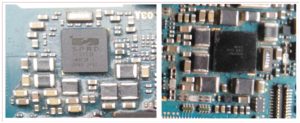
2.PFO/PA IC
The power amplifier IC is also connected to the network. The function of this IC is to amplify the RF signal emitted from the mobile phone to a sufficient level (as required) and send it. When we are talking from one mobile phone to another, our voice is amplified by the power amplifier IC and sent out. In this case, the IC takes the most current. When it comes to network problems on mobile phones, this IC is the one that gets worse. How to find the power amplifier IC on the motherboard of the mobile phone? The power amplifier IC is equipped with an external antenna socket and a G.S. The M. antenna is placed near the interface. This power amplifier IC is also slightly higher than other ICs. Some power amplifiers are also given a sign above the IC (on the body) as shown in the picture below.
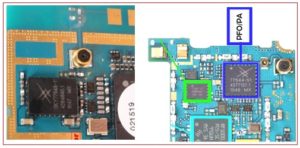
3.Network IC(RF IC)
This IC is called a network because it is related to the mobile phone network. This network IC is also called RFIC or Baseband IC. The main function of this network IC is to link between the mobile phone set and the mobile phone tower outside. The power signal amplifier IC is filtered and amplified to reach the network IC, and the network IC converts the signal into an intermediate signal and performs various functions such as amplification, mixing and demodulation. How to find network power IC on mobile phone motherboard? The motherboard of the mobile phone has RF Kristal and bandpass filters around the network IC. Some motherboards may also have couplers around the network IC. 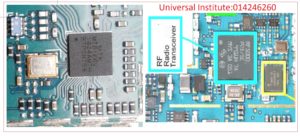
4.Wi-Fi IC(W-LAN)
Wi-Fi for wireless local area network on mobile phones. IC is kept. Through this IC we can access the internet without a SIM card. The function of Wi-Fi IC is to link between mobile phone sets and home Wi-Fi routers through frequency. Bluetooth IC is packaged within WiFi IC in all the smart mobile phones currently coming in the market. How to find WiFi on mobile phone motherboard? There is also an oscillator that produces a certain value of frequency near Wi-Fi. The exterior of this oscillator can be shaped like an RF coil or a coupler. There is also an antenna interface near the IC. Note: If the RF is placed near the Wi-Fi IC and the network IC, it is difficult to distinguish which network IC and which Wi-Fi IC. The Wi-Fi IC is housed alone on the motherboard, while the network IC, power amplifier IC and bandpass filters are placed nearby.
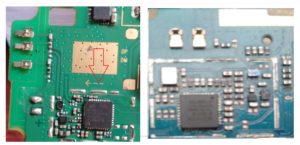
5.Processer(CPU)
Other ICs used in mobile phones process input and output data between Power IC, Network IC, WiFi IC, Charging, Sound IC, USB IC. In this way, the processor is exchanging all the data between everyone. That is why this IC is called Central Processing Unit CPU. The processor is considered to be the most important IC because other ICs work under the direction of this IC. How to find the processor IC on the motherboard of the mobile phone? The processor in mobile phones is a bit bigger than other ICs, the exterior is also better and often in Square Shape. Chinese and high-end mobile phones often use processors such as Spreadtrum, MTK (Media Tek), MStar, Infineon, Sky Works. 
6.Flash Memory (NAND/eMMC/eMCP)
The operating software for operating the mobile phone is kept within this memory. This flash memory is also called (NAND / EMMC / EMCP / UFS IC). The commands we give from the keypad or touchpad of the mobile phone go directly to the memory through the processor and the processor reads and writes the data in the memory. Such memories are used in different sizes (Capacity) according to the mobile phone. This memory contains operating software as well as space for storing user data. How to find flash memory IC on mobile phone motherboard? Flash memory is placed close to the processor and it does not have as many small components as other ICs. Flash memory is in IC (Rectangle Shape).
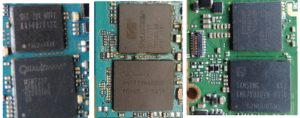
7.Touch IC
This type of Touch IC is used in all smart mobile phones. This Touch IC is used as the interface between the Touch Pad and the processor of the mobile phone. If this IC is bad, the touch pad will not work. Touch IC is placed on the address of the touch pad in most mobile phones and on the motherboard in some mobile phones.
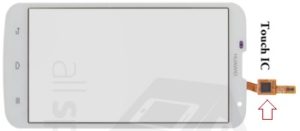
8.USB IC (OTG IC)
USB IC drives data as an interface to the device connected between the processor and the micro USB connector. How to locate USB IC on mobile phone motherboard? USBIC is often connected to a charging connector or power IC. Is placed nearby. This IC is a bit smaller than other ICs and the non-polar capacitors are housed close to this IC, as in the Power IC.  9.LED Driver IC(Light IC)
9.LED Driver IC(Light IC)
The lead diver IC is designed to give voltage to the LEDs placed inside the display of the mobile phone. Lead diver IC and boost coil are given to the lids placed inside the display by boosting the voltage. If this IC is bad, the back light will not come. How to find lead diver IC on mobile phone motherboard? The lead diver IC is much smaller in size than other ICs and a boost coil is placed near this IC.

10.Voltage Regulator IC(DC to DC Converter-LDO)
The voltage regulator IC is used to regulate the voltage like the power IC. This type of IC is also called DC to DC Converter (DC to DC Converter) IC. It can also be like the external structure and size of the IC.
11.Audio Ampilifier IC
The audio amplifier IC is to amplify the audio signal and give it to the ringer speaker. It is connected to the IC Ringer speaker. If the IC is bad, the mobile phone will not ring and the hands will not be free. This IC is also found in small size only on bar phones near the speaker interface.
12.Protection IC
A small IC placed on a mobile phone for security is called a protection IC. This protection is usually made by placing diodes and resistors inside the IC. This type of IC is found for protection around SIM connector, memory connector, headphone connector, display connector, USB connector.
Mobile Connector ,Interface & Test Point (Charging Connector,Battery Connector, Memory Connector ,SIM Connector, Camara Connector, Display Connector)
What is the IMEI No of a mobile phone and why is it kept?
IMEI (International Mobile Equipment Identity) is a 15-digit number that appears on the back of the mobile phone set or on the cover as shown in the picture below when the battery is removed. Such IMEI No. Because of the identity of the mobile phone, each set is different. In fact, this number is like the engine number of a Vehicle. IMEI No. Apart from the battery cover, the chip in the PCB (Motherboard) of the mobile phone set is kept inside.The IMEI No. of the mobile phone press *#06# View directly from Key Pad or Touch Pad. IMEI No. Since the manufacturing company has different models for each model, if a mobile phone is stolen or lost, it can be traced by looking at the same number. IMEI No. of mobile phone set This number is not easily changed as it is very necessary for security. Hackers use some tools to use IMEI No. Changed but found to have done so will result in legal action.
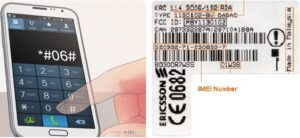
Mobile Cell Phone Repairing Dictionary( Glossary)
1G: 1St Generation in Mobile Telephony. 2G:
2Nd Generation in Mobile Telephony. 3G:
3Rd Generation in Mobile Telephony. 4G:
4Th Generation in Mobile Telephony.
5G : 5th generation mobile Telephony.
3GP: 3rd Generation Video Format
AVI: File Format for Video Files
AV: Audio/Visual
AC: Alternate Current.
AFC: Automatic Frequency Control
APN:Access Point Name
BGA: Ball Grid Architecture
BSC: Base Station Controller
BTS: Base Transceiver Station
BSI: Battery Status Indicator.
CDMA: Code Division Multiple Access
CPU: Central Processing Unit
CD: Compact Disk
DTMF: Dual Tone Multi Frequency
DCS: Digital Cellular System
DVD: Digital Versatile Disk or Digital Video Disk
DCT: Digital Core Technology.
FBUS: Fast Serial Bus
GSM: Global System For Mobile Communication
GPRS: General Packet Radio Service
GB:Gibabyte HTTP: Hypertext Transport Protocol
HSCSD:High Speed Circuit Switched Data
ISP: Internet Service Provider
IC: Integrated Circuit.
IP rating:Ingress Protection rating
IMEI: International Mobile Equipment Identity
IMAP:Internet Message Access Protocol
JPEG: Joint Photographic
Kbps:Kilobytes per second
LAN: Local Area Network
LCD: Liquid Crystal Display
Li-Ion:An abbreviation for Lithium-ion
LED:Light Emitting Diode.
MB:Megabyte
Mp3: An Audio File Format
MP3 MPEG: Motion Picture Experts Group
MTSO: Mobile traffic Switching Office
MSC Mobile Switching Center
MMC: Multimedia Card
Midi: Mutual Instrument Digital Interface
MF: Multi Frequency Tones
MNO:Moblie Network Operator
Megapixel:A megapixel is one million pixels
MMS:Multimedia Messaging Service
OS:Operating System
PCS: Personal Communication Service
PCB: Printed Circuit Board
PFO: Power Frequency Oscillator
PMM: Permanent Memory Management
PPM: Post Programmable Memory
PX: Receiving Signal
PIN:Personal Identification Number
PUK:Pin Unblocking Key;
PSTN:Public Switched Telephone Network
PTT:Push To Talk
RTC: Real Time Clock.
RX: Receive / Receiver (Receiving Section).
PDA: Personal Digital Assistant.
RAM: Random Access Memory.
ROM: Read Only Memory.
RF:Radio Frequency
SP LOCK: Service Provider Lock
SIM:Subscriber Identity Module
SMD: Surface Mount Device
SMS:Short Message Services
SAR:Specific Absorption Rate
TX: Transmitting Signal
TFT:Thin Film Transistor
USB: Universal Serial bus
UEM: Universal Energy Manager
USIM:Universal Subscriber Information Module
UMTS:Universal Mobile Telecommunications Service
VGA:Video Graphics Array
Wi-Fi : ‘Wireless Fidelity’
WTTP: Wireless Application Protocol
WWW: World Wide Web
WAV: An Audio Format
WCDMA:Wideband Code Division Multiplexing Access
WAP browser:A Wireless Access Protocol browser
Related Posts:
- Computer/Laptop repair (Advance Chip Level)
- Advance Mobile Software (A to Z Full)
- TV(LCD/LED/Smart) Repair Course
- Basic Electronics Course 30 days
- AC & Fridge Repair Training 60 days
- Washing Machine Repair Course-30 days
- Building Electricians(House wiring) 45 days
- CCTV Camera Opearting & Installation 45 days
- Home Appliances Repair Training 45 days
- Mobile Repair eBook (Nepali Language)
- Mobile Repair eBook (English Language)
- Mobile Repair Course Contain
